Can you remember the last time you saw a young child share their favorite toy without a parent having to prompt them? Or perhaps you recall the moment when a quiet student stood up in class and confidently voiced their opinion for the first time?
These aren’t just cute “kids being kids” moments; they’re pivotal life skills in action, a glimpse into the world of Social Emotional Learning, fondly abbreviated as SEL. 🌟
In the sections ahead, we’ll demystify this transformative approach to education and personal development. We’ll explore the five core competencies that make up SEL, from self-awareness to responsible decision-making. And we’ll do so in a way that’s easy to understand and apply in your own life. 📘
Why is SEL so crucial, you ask? We’ll delve into its far-reaching benefits, not just for children but for adults as well. From boosting academic performance to enhancing emotional well-being, SEL is the unsung hero in the story of lifelong success and happiness. 🌈
Whether you’re a teacher seeking to create a nurturing classroom environment or a parent aiming to foster emotional intelligence in your child, this article is your comprehensive guide. We’ll offer practical tips, share insights from both educational and parental perspectives. And even discuss how SEL can be the bridge that improves communication between home and school. 🏠🏫
So grab your favorite cup of coffee ☕ or settle into a comfy chair. We’re about to embark on an enlightening journey. A journey that promises to transform our classrooms, our homes, and most importantly, the hearts and minds of our children. 🌱
What is Social Emotional Learning? 🌱
So, you might be wondering, what’s the big deal with SEL? Why is everyone—from educators to parents—buzzing about it? Well, let’s demystify this powerhouse of a term.
At its heart, Social Emotional Learning is like a life skillset we all wish came as a manual with every newborn. It’s the how-to guide for understanding ourselves and others. It provides the rules for playing well with others and making responsible choices. In essence, it teaches us how to be good humans.
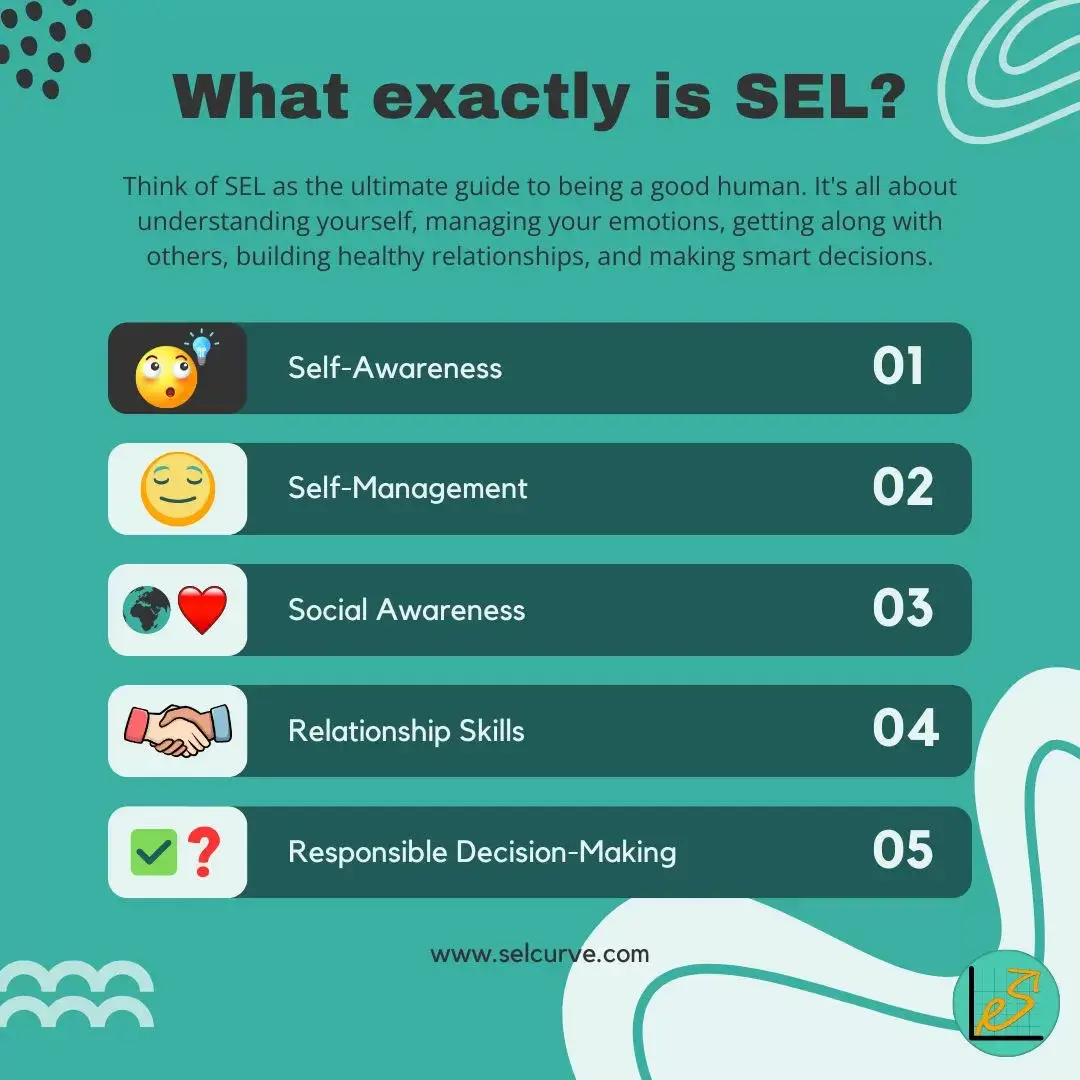
According to the Collaborative for Academic, Social, and Emotional Learning (CASEL), students who participated in SEL programs showed an 11% increase in academic achievement compared to those who did not.
Still a bit fuzzy? Let’s break it down further by zooming in on the five core competencies that make up SEL. Think of these as the building blocks or the ingredients in a recipe for creating emotionally intelligent individuals.
1. Self-Awareness
You know how sometimes kids (and hey, even us adults) can be a whirlpool of emotions? Self-awareness is like handing them a flashlight to explore what’s going on inside.
This skill helps them recognize their own feelings and understand why they’re feeling a certain way. It even helps to predict how their emotions could influence their actions. It’s like being a mini-detective of your own mind. 🕵️♀️
2. Self-Management
Once you know what you’re feeling, what do you do with that information? Think of self-management as the emotional traffic light. 🚦
It teaches us when to stop (control impulses), think (assess the situation), and then act (make the right choices).
Got angry feelings? Self-management tools teach kids how to ‘pause’ before reacting. It’s like having a built-in chill button!
3. Social Awareness
Imagine a child in the playground, noticing another kid sitting alone and looking sad. Social Awareness is what nudges them to go over and ask, “Are you okay?”
It helps us tune into other people’s feelings and see things from their point of view. It’s about understanding social cues, reading the room, and showing respect for others. In simpler words, it’s being a good friend and neighbor. 🤝
4. Relationship Skills
Ah, the art of getting along with others! This is where kids learn how to make friends, resolve squabbles, and cooperate in a team.
Whether it’s sharing toys or negotiating who gets to be the team captain, these skills are what make those interactions smooth and enjoyable.
It’s the nuts and bolts of how to be a good friend, family member, and someday, a great partner or colleague.
5. Responsible Decision-Making
Last but definitely not least, this is the competency that ties everything together. Imagine your child facing a dilemma: to share their last piece of candy with a friend or keep it for themselves.
Responsible decision-making acts as an internal guide. It helps them weigh the pros and cons to make a choice they feel good about. It’s the mental checklist that helps kids (and adults) think before they act.
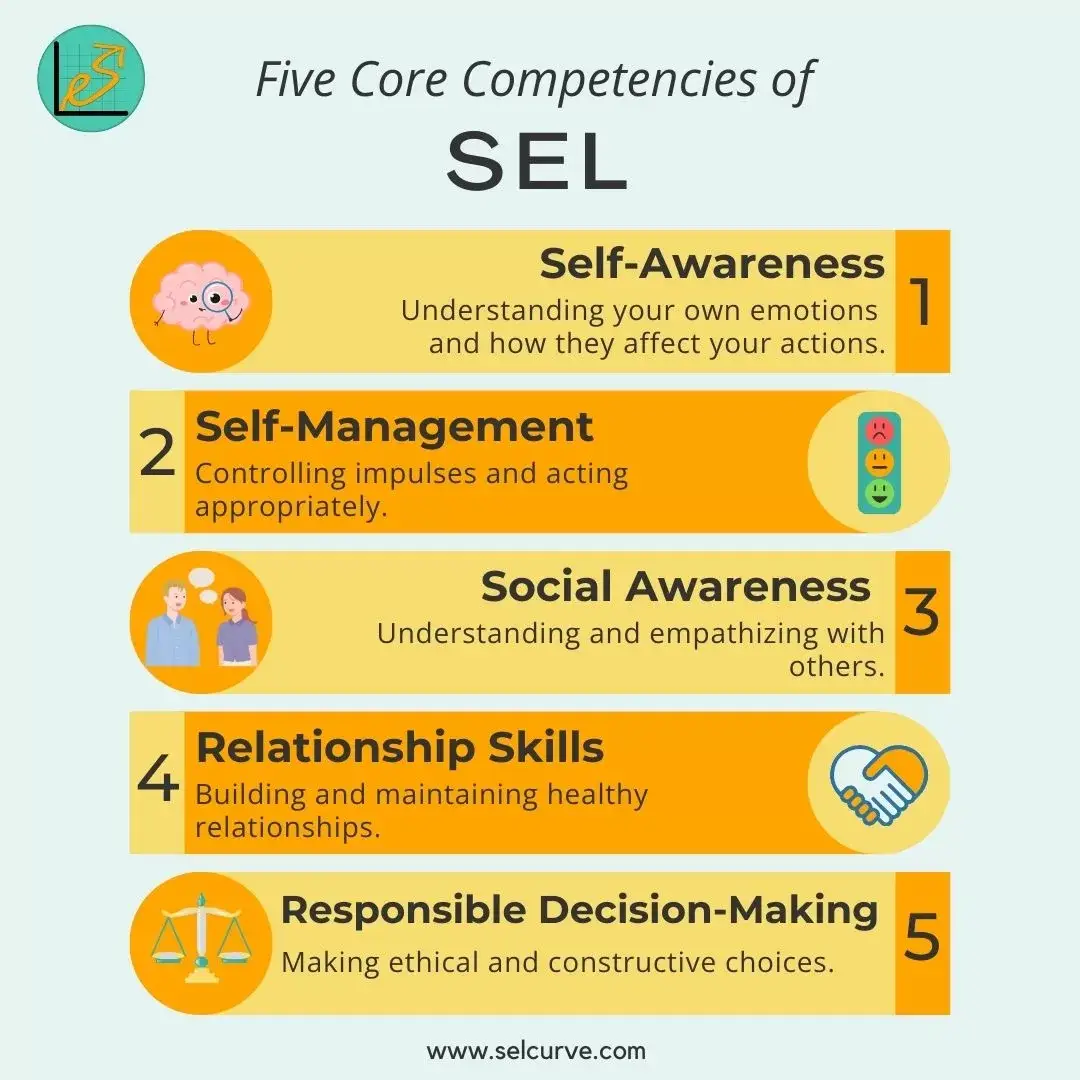
A study published in the Journal of Applied Developmental Psychology found that SEL programs led to a 22% improvement in social behaviors and a 9% reduction in problem behaviors.
As we’ve explored, Social Emotional Learning is far more than a trendy educational term. It’s a foundational framework for nurturing emotionally intelligent, compassionate, and resilient individuals. But you may still be wondering, ‘Why should I prioritize SEL for my child or my students?’
Well, the benefits are both immediate and long-lasting. They impact not just emotional well-being but also academic performance, mental health, and so much more.
Ready to dive deeper? Let’s explore why Social Emotional Learning is not just important, but essential, in the next section.
Why is Social Emotional Learning Important? 🎯
You’ve likely heard phrases like “emotional intelligence is as important as IQ” or “soft skills are the new hard skills.” But let’s be real—what does this actually mean for your child or your students? Why should we prioritize SEL right alongside math, science, and literature?
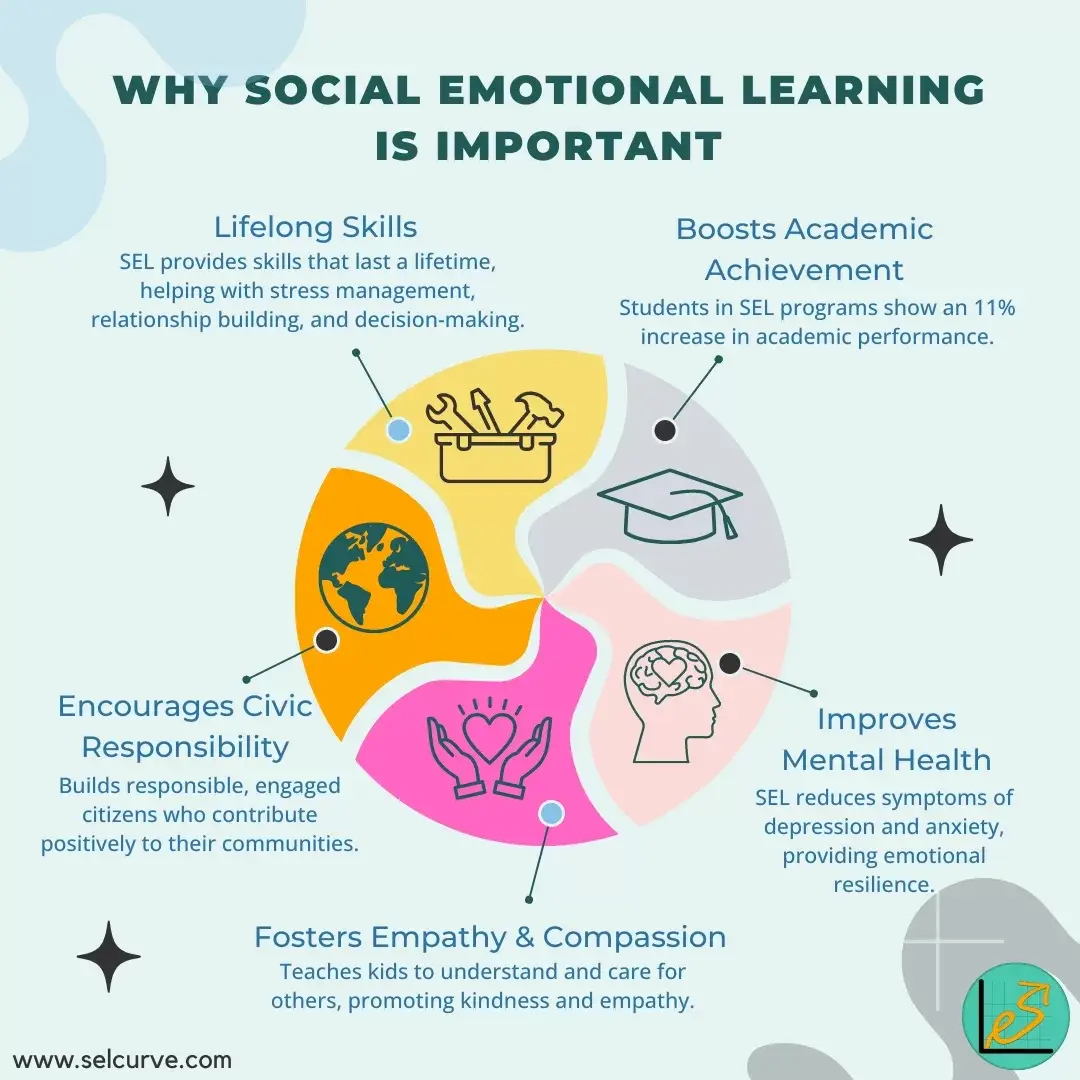
Lifelong Benefits
First off, the skills learned through SEL aren’t just for the kiddo years; they’re lifetime skills. Imagine having a toolbox that you carry with you throughout your life—a toolbox filled with the ability to handle stress, forge strong relationships, and make thoughtful decisions.
According to a long-term study published in the American Journal of Public Health, SEL programs were found to have lasting positive effects on academic performance and well-being up to 18 years later.
This isn’t just a fad; it’s a lifelong investment in well-being and happiness. 🛠️
Academic Achievement
Okay, for those of you thinking, “That’s all great, but what about grades and academic performance?” Well, hold onto your hats because SEL is a superhero in that department too!
A meta-analysis of 213 studies involving more than 270,000 students found that those who participated in SEL programs had an average of 11% higher academic achievement compared to those who did not.
That’s right; SEL can actually boost those ABCs and 123s! 📚
Mental Health Matters
In a world where stress and anxiety seem to be at an all-time high, especially among young ones, SEL serves as a safeguard. It’s like emotional armor.
Research from the University of British Columbia found that SEL programs led to a significant reduction in symptoms of depression and anxiety among students.
By practicing self-awareness and self-management, kids learn coping mechanisms that can help them navigate through emotional and mental challenges. And let’s be honest, couldn’t we all use a little emotional armor sometimes? 🛡️
Empathy and Compassion
The golden rule of treating others how you want to be treated? That’s SEL in action. Teaching empathy and compassion are cornerstones in raising kind-hearted human beings. So when we talk about building a better world for tomorrow, it begins with instilling these qualities today. 💖
Civic Responsibility
Last but not least, SEL is crucial for creating responsible and engaged members of society. Through relationship skills and responsible decision-making, kids learn the value of collaboration, respect, and community engagement. In other words, they become the type of people who stand up for what’s right and contribute positively to their community.
So, if you’ve been wondering whether SEL is worth all the buzz, I hope you’re starting to see that it’s not just a buzzword—it’s a life-altering, world-changing philosophy. It holds the potential to turn classrooms into nurturing spaces and homes into havens of emotional well-being. Most importantly, it can help children become self-aware, compassionate, and resilient adults.
Feeling inspired? I hope so! 😊 Because next up, we’ll explore how SEL impacts children of all ages, and how it’s never too late (or too early!) to start this incredible journey.
[wpdiscuz-feedback id=”lb9afp43hk” question=”What do you think?” opened=”0″]<em>How are we doing so far? Are you feeling the significance of SEL as much as we are? </em>[/wpdiscuz-feedback]
Lifelong Impact of Social Emotional Learning 🌳
When I say “all ages,” I mean it! From the toddler years to the tumultuous teens and even beyond, SEL offers a treasure trove of benefits that are age-appropriate and incredibly relevant.
According to a study published in the journal “Child Development,” students who participated in SEL programs showed an 11% increase in academic achievement and a 10% improvement in social behaviors. This evidence highlights that Social Emotional Learning is universally applicable. Whether you’re late to the game or just starting out, it’s always the right time for this incredible journey.
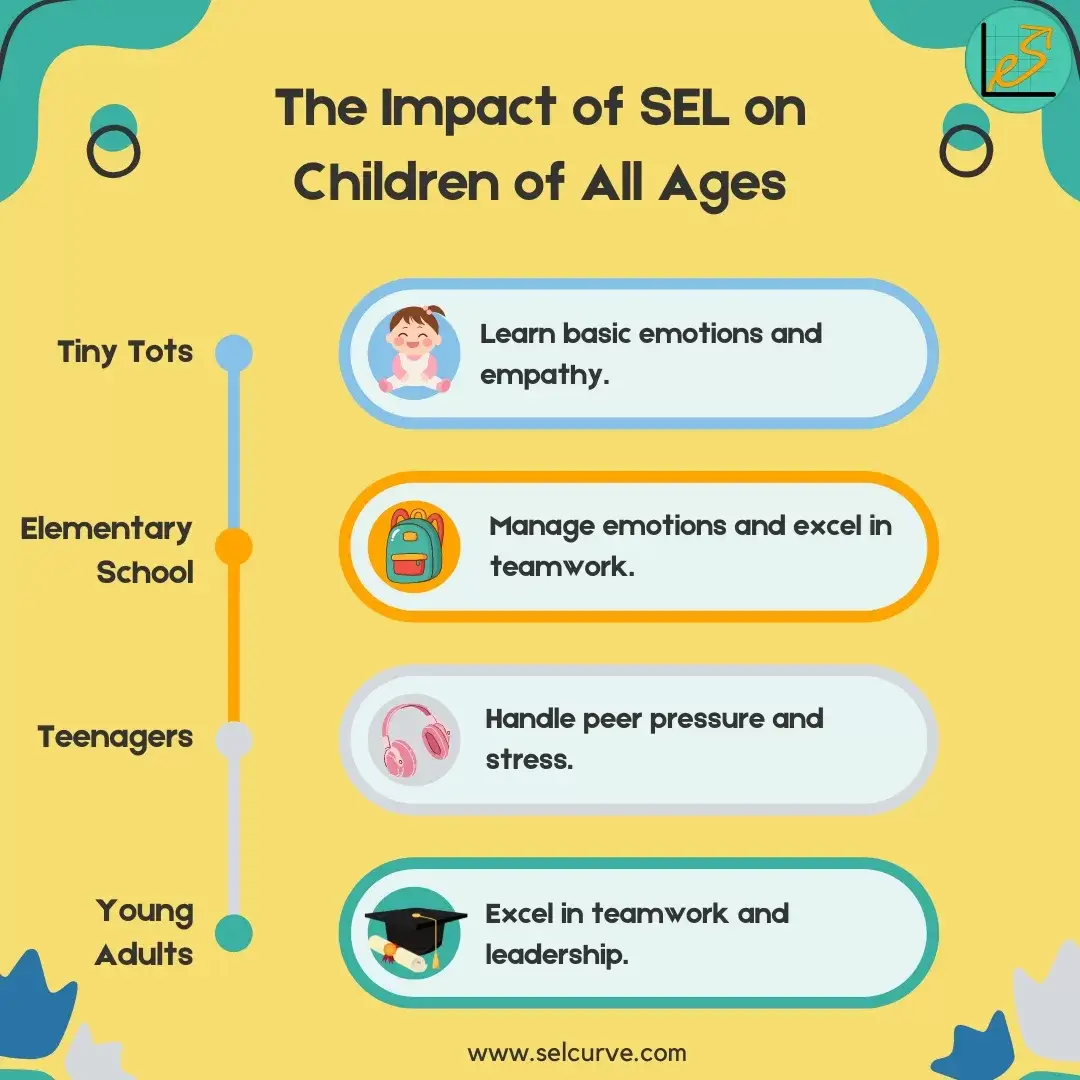
Let’s take a little journey through the life stages, shall we?
Tiny Tots and Preschoolers 🧒
Okay, let’s start with our littlest ones. SEL for tiny tots? Absolutely! In fact, the earlier, the better.
Picture this: Your 3-year-old is having a meltdown because they don’t want to share their toy truck. A classic toddler moment, right? But what if, instead of a tantrum, they could express, “Mom, I’m feeling upset because I want to play with my truck alone right now.” How groundbreaking would that be?
With SEL, kids as young as 2 or 3 can start learning the basics of emotion identification and even rudimentary problem-solving. They start learning empathy by identifying emotions in others. This lays the groundwork for lifelong emotional intelligence.
Elementary School Explorers 🎒
As kids enter school, the stakes get higher. There are friendships to navigate, rules to follow, and new challenges to tackle, both academically and socially.
SEL comes to the rescue by equipping them with the tools they need to manage their emotions and understand others. It also helps them excel in teamwork.
Whether it’s dealing with a tricky math problem without giving up or resolving a playground dispute peacefully, SEL is like the Swiss Army knife of life skills for this age group.
Teen Titans 🎧
Ah, the teenage years, a time of self-discovery, pushing boundaries, and, let’s be honest, a rollercoaster of emotions. At this stage, SEL can be a game-changer.
Teens with strong SEL skills are better equipped to handle peer pressure, navigate complex social scenarios, and make responsible decisions. They can manage stress—which let’s face it, is pretty high during the teen years—constructively.
So, instead of slamming doors and blasting emo music (not that there’s anything wrong with a good emo phase!), they’re more likely to seek constructive solutions.
Beyond School 🎓
Even after the caps are thrown in the air and school days are behind them, the benefits of SEL continue to shine.
As young adults navigate the world of higher education or step into their first jobs, those skills of emotional intelligence, problem-solving, and effective communication can truly set them apart. They’ll be the ones to excel in teamwork, adapt well to challenges, and become leaders in their fields.
From first steps to first jobs, the positive impact of SEL is nothing short of phenomenal. It shapes resilient, compassionate, and effective individuals who are equipped to handle life’s ups and downs. The best part? These skills continually evolve and adapt, proving useful at every stage of life.
Feeling enlightened and excited? I sure hope so! 🌟 Up next, we’ll be diving deeper into how social emotional learning not only helps kids but also plays a vital role in the well-being of adults. Yes, it’s full-circle magic, and you won’t want to miss it!
[wpdiscuz-feedback id=”lb9afp43hk” question=”What do you think?” opened=”0″]<em>How are we doing? Are you starting to visualize the incredible journey of SEL through the different stages of childhood? </em>[/wpdiscuz-feedback]
SEL for Well-Being 😊
SEL isn’t just child’s play; it’s a lifetime adventure. From sharpening emotional intelligence to fortifying resilience, let’s discover how this dynamic approach nourishes the hearts and minds of both kids and adults.
A study published in the “Journal of Applied Psychology” found that adults with higher emotional intelligence reported better well-being and lower levels of stress. This isn’t just beneficial for children; it’s a lifelong skill that can dramatically improve your quality of life.
Now, take a moment to reflect on your own emotional intelligence and resilience. How could these skills serve you in your daily life?
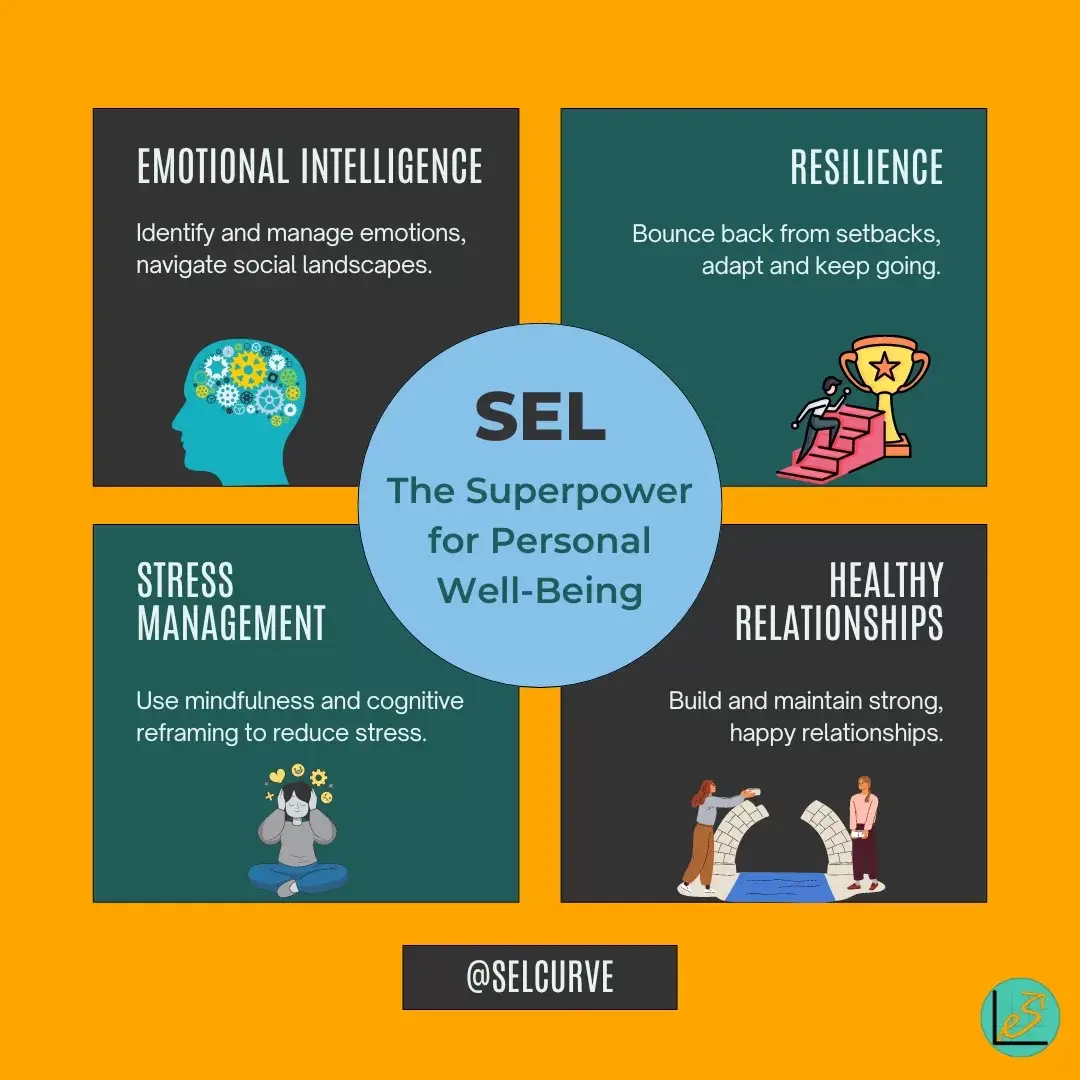
Emotional Intelligence Unleashed 🧠
First things first, let’s talk Emotional Intelligence, or EI for short. Emotional intelligence isn’t about being “touchy-feely”; it’s about being smart with your feelings. It’s the skill that allows us to identify our own emotions and the emotions of others. Thus guiding our behavior and relationships.
Now, why does that matter? Well, consider this: EI helps your child navigate friendship issues at school. And it helps you, as an adult, to successfully manage work relationships and build stronger bonds with family and friends. It’s like having a GPS for navigating social and emotional landscapes!
Resilience: Bouncing Back Better 💪
Life has its share of setbacks and challenges, whether you’re 6 or 60. How we respond to those challenges can shape our future. Resilience is that incredible ability to bounce back from adversity, to adapt and keep going.
Imagine your child facing a low grade in a class they worked hard for. With strong SEL skills, they can analyze what went wrong, adapt their approach, and try again with renewed spirit. The same goes for you—facing a challenge at work or in personal life becomes a stepping stone, not a stumbling block. And that, my friends, is resilience in action!
More Joy, Less Stress 🌈
Ever felt overwhelmed with stress? We all do at times, don’t we? Well, guess what, SEL has a magical way of turning stress into an emotional learning experience.
Through techniques like mindfulness and cognitive reframing, kids learn to face challenges with a more balanced emotional outlook. And the same skills can help you, as an adult, to manage stress and anxiety. Ultimately leading to a healthier, happier life.
Healthy Relationships, Happy Lives 👨👩👦
Last but never least, SEL plays a monumental role in relationship-building.
Be it a young child learning the value of sharing and friendship. Or an adult understanding the dynamics of a successful partnership. SEL fosters the skills needed to build and maintain healthy relationships. After all, as humans, our relationships are at the core of our happiness, aren’t they?
So, whether you’re focused on raising emotionally intelligent and resilient kids, or you’re an adult looking to fine-tune your own emotional skills, SEL is your lifelong friend. It’s never too late or too early to embark on this enriching journey.
Are you as pumped about this as I am? Because next up, we’ll dig into how Social Emotional Learning intersects with education, creating a more holistic learning environment. Trust me, you’ll want to be around for that revelation! 🌈
[wpdiscuz-feedback id=”lb9afp43hk” question=”What do you think?” opened=”0″]<em>Feeling connected? Are you seeing how SEL isn’t just for children but is a full-circle approach to well-being for all ages? </em>[/wpdiscuz-feedback]
Social Emotional Learning in Education 📚
I’m so excited that you’re still with me on this enriching journey through the world of SEL! We’ve chatted about its positive impact on emotional intelligence and resilience. But now let’s get into the nitty-gritty of where most of us spend a significant chunk of our childhood—school. 🎒
Let’s talk school—the place where kids learn everything from ABCs to algebra. But hey, shouldn’t the learning go beyond just textbooks? What if schools could also be platforms for children to become confident, emotionally balanced, and socially adept individuals? This is where SEL shines as a true rockstar! 🌟
For instance, the CASEL-supported school district in Austin, Texas, integrated Social Emotional Learning into their curriculum and saw a 5% increase in graduation rates and a 4% increase in attendance. These improvements demonstrate that SEL is not just a feel-good program but a transformative educational strategy.
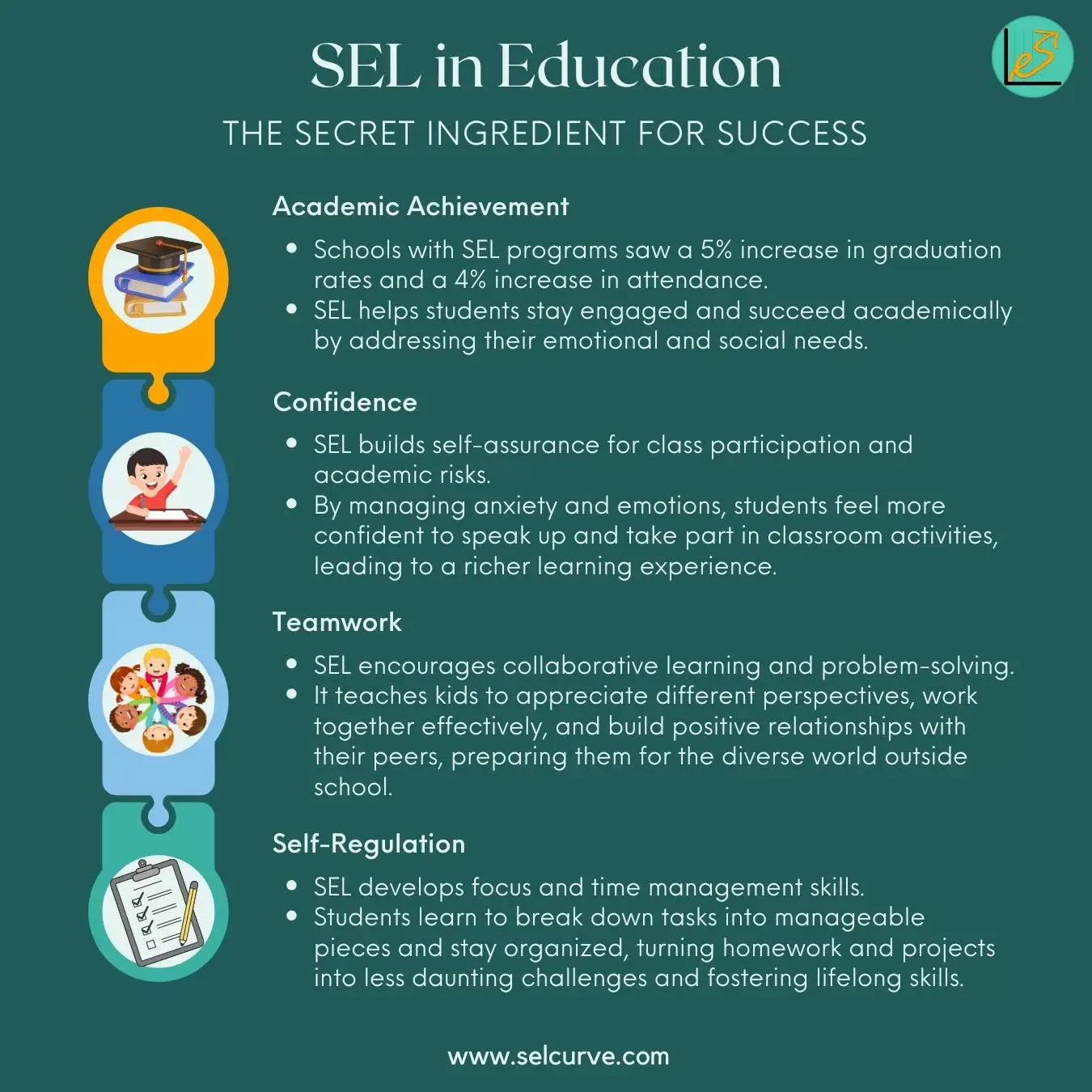
Now, let’s not get it twisted: traditional academic subjects are absolutely essential. But SEL complements these subjects beautifully, offering a well-rounded schooling experience that includes lessons in empathy, self-awareness, and emotional regulation. It’s not an alternative to traditional education; it’s an enhancement that prepares children for the complexities of real life.
A+ for Emotional Skills 📚
Now, let’s not get it twisted: traditional academic subjects are absolutely essential. We all want our kids to excel in math, science, and literature.
But, how many times have you seen a kid with straight A’s struggle to articulate their feelings or resolve a disagreement? That’s because emotional intelligence is a subject that seldom gets taught in regular curricula. This is where SEL steps in.
By integrating SEL into education, we’re giving children a well-rounded schooling experience. Which includes lessons in empathy, self-awareness, and emotional regulation. And guess what? Kids with strong SEL skills actually perform better academically. It’s a win-win!
The Confidence Boost Kids Need 👊
Remember that time you had to speak in front of the class and felt butterflies in your stomach? Or when your child hesitated to raise their hand to answer a question? Well, SEL helps build confidence by teaching kids how to manage their anxiety and emotions.
This newfound self-assuredness translates into more active participation in class, a willingness to take academic risks, and a general enthusiasm for learning. The result? You guessed it—better academic performance.
Teamwork Makes the Dream Work 🤝
One of the most significant life lessons is understanding the value of teamwork. And guess what, SEL champions this lesson like no other.
Through activities that encourage collaborative learning and problem-solving, kids learn to appreciate different perspectives and build positive relationships with their peers. This not only enriches their social life but also prepares them for the diverse world awaiting them outside the school gates.
Self-Regulation: The Homework Helper 📝
We’ve all had those nights—both as kids and parents—when homework seems like an insurmountable mountain. The ability to focus and manage time efficiently is something even many adults struggle with.
SEL practices help children develop self-regulation skills, turning that mountain of homework into manageable, bite-sized pieces. This skill will not just get them through school but will be a lifelong asset in personal and professional settings.
So, the next time you look at your child’s report card, remember that the grades are just a piece of the pie. The emotional and social skills they’re gaining through SEL complete that pie. Turning it into a delicious, well-rounded treat of personal growth and academic success.
Get ready for the next leg of our journey where we’ll look at the classroom from the teacher’s perspective. Trust me, it’s an angle you won’t want to miss! 🌈
[wpdiscuz-feedback id=”lb9afp43hk” question=”What do you think?” opened=”0″]Feeling enlightened? I hope so! It’s just incredible how SEL fits like a puzzle piece into the educational journey, enriching it in every imaginable way. [/wpdiscuz-feedback]
Teacher’s View on Social Emotional Learning 📖
As we’ve talked about its incredible impact on kids, parents, and academic life, let’s now shift gears and put on our “teacher hats.” Trust me, the view from the front of the classroom is both illuminating and inspiring! 🍎
Ah, the life of a teacher! It’s not just about grading papers and lecturing on the history of the world. Teachers wear multiple hats—they’re educators, mentors, and sometimes even a shoulder to cry on. No wonder they are one of the most significant influencers in a child’s life.
Teachers who have integrated SEL into their classrooms often report a noticeable shift in the atmosphere. They often talk about how the classroom becomes a more collaborative space. How students seem more engaged, and how even academic performance tends to improve. It’s not a magic wand, but it’s close.
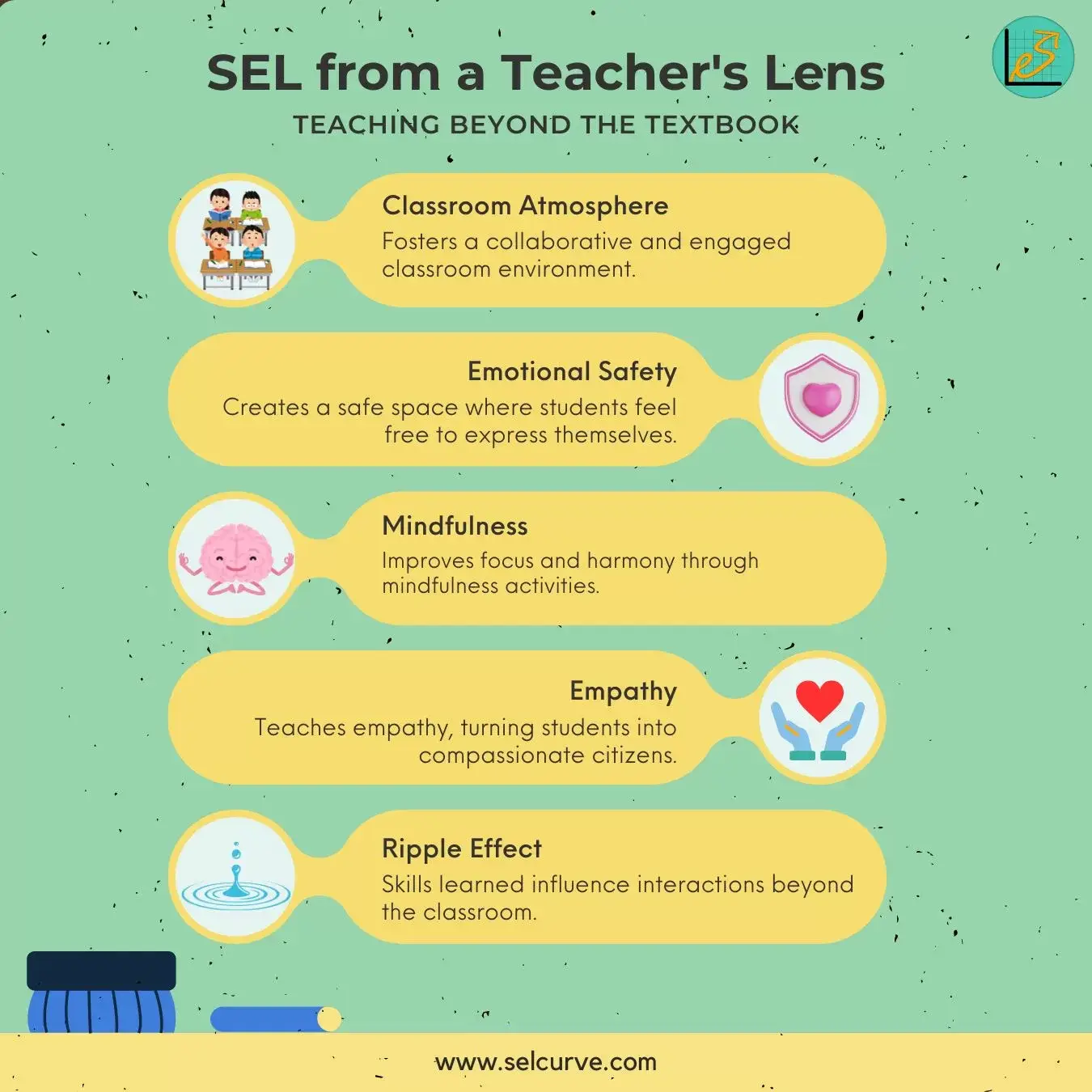
So, let’s delve into how Social Emotional Learning can enrich your role as a teacher, shall we?
The Classroom: A Microcosm of Society 🏫
Teachers, do you ever feel like your classroom is a little universe unto itself? You’ve got future artists, scientists, and leaders all under one roof. But with great diversity comes great responsibility—to create an inclusive environment where every child feels seen and heard.
This is where your SEL toolkit comes in handy. By fostering empathy and understanding among students, you are actually preparing them for the real world. Talk about job satisfaction!
Emotional Safety First 🛑
Remember when you felt scared to speak up in class because you were afraid of making a mistake? In an emotionally safe classroom, this fear is replaced by the courage to try, fail, and try again.
As a teacher, when you employ SEL techniques like active listening and validation, you make your classroom a sanctuary. A safe space where students feel free to express themselves—enhancing their emotional well-being.
The Magic of Mindfulness 🧘♀️
Picture this: It’s been a long morning, and your students are restless. Imagine if, instead of powering through the restlessness, you took a five-minute “mindfulness break.”
Through simple mindfulness activities, you can teach your students to become aware of their feelings and refocus their energies. The result? Better attention spans and a more harmonious classroom.
The Empathy Muscle 💪
Teaching is not just about imparting knowledge; it’s about imparting wisdom. And empathy is one of the wisest skills you can teach.
By modeling empathy in the classroom, you’re not only making school a better place but also sending compassionate citizens out into the world.
The SEL Ripple Effect 🌊
Just think about it: every kind word, every lesson in managing emotions, and every teamwork activity has a ripple effect that extends beyond the classroom walls.
The emotional and social skills you teach your students will influence how they interact with their families, friends, and eventually, their own kids and coworkers.
So, teachers, as you read this, consider the transformative power you hold.[wpdiscuz-feedback id=”44lvgxjlcw” question=”What do you think?” opened=”0″] How could your classroom change if you made SEL a daily practice?[/wpdiscuz-feedback] Your influence doesn’t stop when the school bell rings; it echoes throughout the lives of your students. And that’s a huge, beautiful deal.
Let’s continue this SEL journey, shall we? Next, we’re diving into strategies for nurturing that all-important teacher-student relationship. You won’t want to miss it! 🌈
SEL for Teacher-Student Bonds 🌈
If you are wondering about how educators can really make a difference, this is where the rubber meets the road. We’re diving deep into the practical stuff now—strategies for fostering a positive teacher-student relationship through SEL techniques. 🌟
Ah, remember your favorite teacher? The one whose classroom felt like a safe haven, where learning felt like an adventure? Well, there’s some heartwarming science behind that.
Studies, like one published in the Journal of School Psychology, show that when students feel connected to their teachers, they’re not just happier; they actually perform better academically.
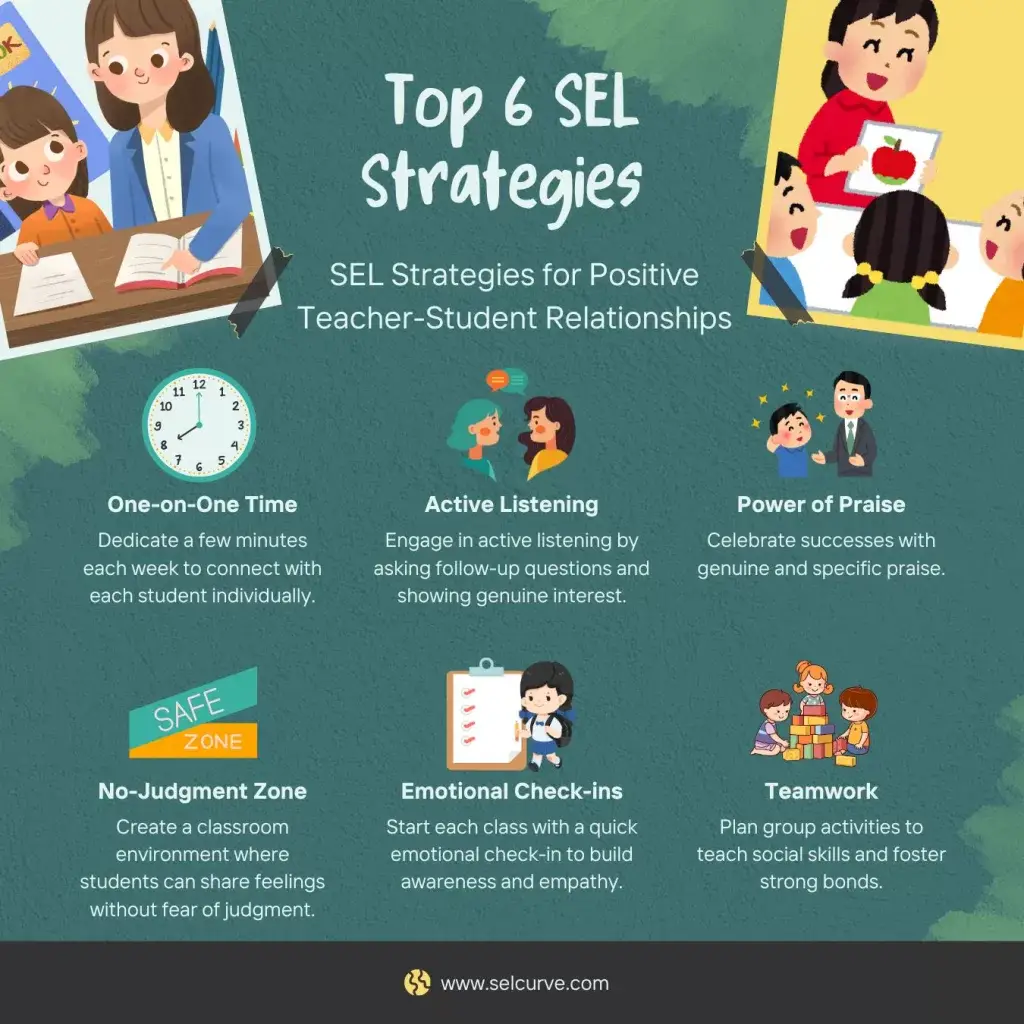
Let’s unpack how SEL can help every teacher become that magical mentor for their students.
The Magic of One-on-One Time 🕰️
Quality time isn’t just for families; it works wonders in the classroom too! Consider dedicating a few minutes each week to connect with each student individually.
It can be a simple “How are you today?” or diving into their thoughts on a recent lesson. This small but impactful gesture can make students feel valued and understood.
Active Listening: Your Secret Weapon 🎯
Picture this: A student is sharing a story about their weekend. You could nod and say, “That’s nice,” or you could engage in active listening. Ask follow-up questions, nod encouragingly, and summarize what they’ve said.
This SEL technique not only makes them feel heard but also teaches them the art of conversation—a double win!
The Power of Praise 🌟
Who doesn’t love a pat on the back? Celebrating your students’ successes, big and small, can do wonders for their self-esteem. But remember, the key is to be genuine and specific.
Instead of a broad “Good job,” how about “Your insights during the group discussion were really helpful!” That way, they know exactly what they did well and are encouraged to do it again.
Creating a ‘No-Judgment Zone’ 🚫
Let’s make the classroom a place where there are no ‘bad’ emotions. Encourage your students to share their feelings without the fear of judgment.
This means also sharing your own emotional ups and downs and how you cope with them. By doing so, you’re helping them build emotional awareness and resilience.
Emotional Check-ins 📋
How about starting each class with a quick emotional check-in? It could be a thumbs-up or thumbs-down system. Or even a mood meter where kids can place their names based on how they’re feeling.
This simple exercise makes kids more aware of their own emotions. And creates an opportunity for empathy and support among classmates.
Teamwork Makes the Dream Work 🤝
Collaboration is a great way to teach social skills and foster strong bonds. Plan group activities that require students to work together.
This can be a science project, a group essay, or even a classroom cleanup. The skills they learn in these collaborations? Priceless.
So, dear teachers, these SEL strategies are more than just techniques; they’re transformative experiences that ripple out, touching not just your students but everyone they interact with. You’re not just building minds; you’re nurturing hearts and shaping the future, one SEL technique at a time.
Ready for the next section? We’ll talk about how Social Emotional Learning helps teachers communicate more effectively with parents. Stay tuned! 💌
SEL in Parent-Teacher Talks 📞
Fantastic! Now that we’ve covered some actionable strategies for teachers, let’s explore another crucial relationship—that between teachers and parents. Oh yes, the parent-teacher dynamic is incredibly important when it comes to SEL. So let’s chat about how understanding SEL can help teachers bridge conversations with parents, about their child’s emotional and social well-being. 💌
You know those parent-teacher meetings that usually focus on grades, attendance, and maybe some classroom behavior? Imagine if those meetings could be so much more. Imagine a conversation that dives deeper into a child’s emotional growth and social interactions, painting a full picture of a young person in bloom. SEL can make that happen.
In fact, a study published in the Journal of School Psychology found that effective teacher-parent communication significantly enhances a child’s social and emotional well-being.
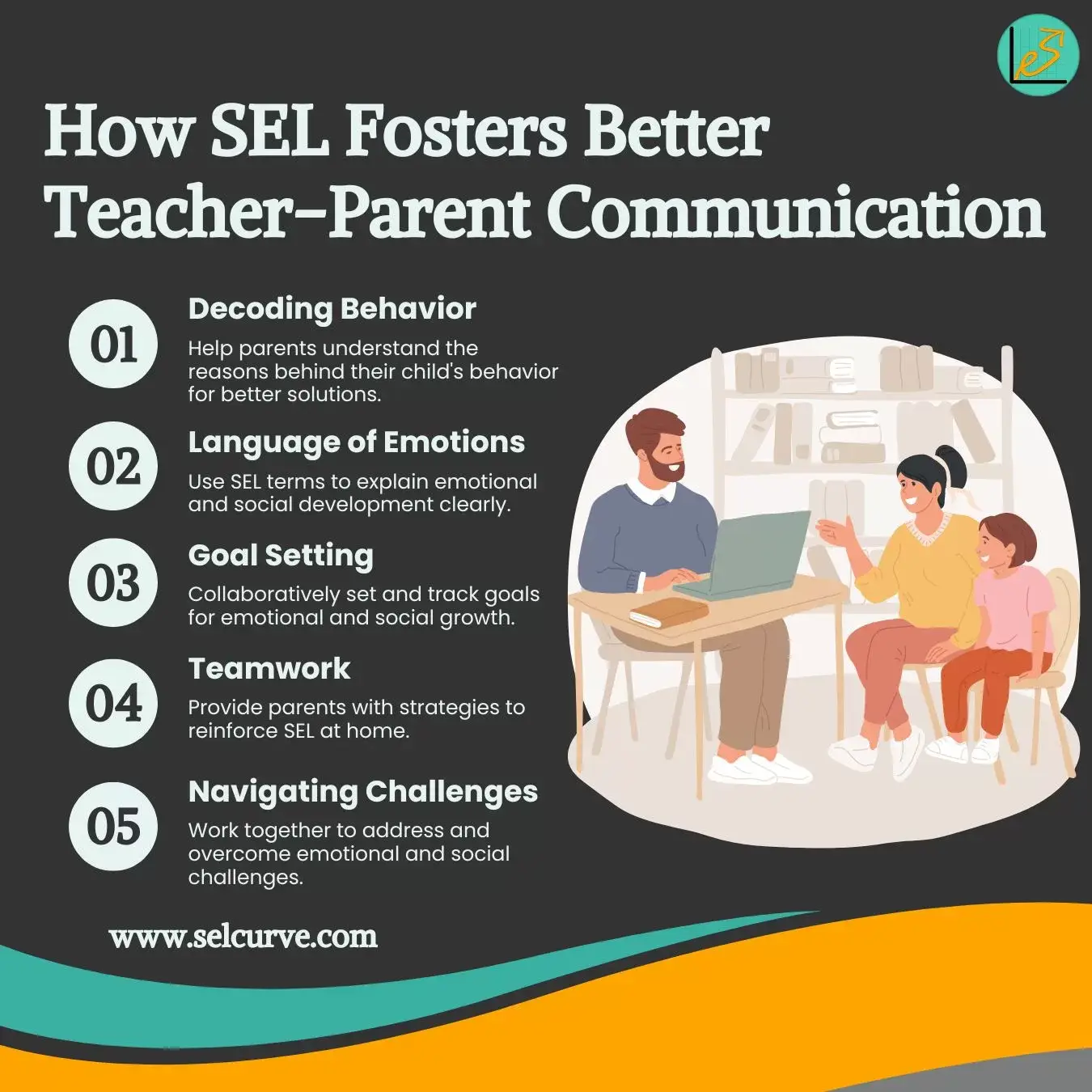
So dear teachers and parents, let’s seize these moments to look beyond the report card. These meetings are golden opportunities to discuss the emotional and social facets of your child’s development. Creating a more holistic understanding of their well-being.
Decoding Behavior 🧩
Teachers, armed with an understanding of SEL, can help parents decode their child’s classroom behavior. Is Miley acting out because she’s looking for attention, or is there a struggle with emotional regulation? This opens the door for constructive conversations that go beyond “Your child needs to behave better.”
Understanding SEL not only helps in identifying the root causes of behavior but also makes the dialogue between parents and teachers more constructive and solution-oriented.
Practical Tip for Teachers: During parent-teacher meetings, consider using a behavior chart that tracks emotional triggers and responses. This visual aid can help parents better understand their child’s behavior patterns and how to address them constructively.
The Language of Emotions 🗨️
Imagine you’re trying to describe a painting but only know the primary colors. Limited, right? Knowledge of SEL provides the vocabulary for discussing intricate emotional hues and tones.
By using this language, teachers can share more nuanced insights with parents, making conversations richer and more constructive.
Goal Setting and Tracking 🎯
A huge benefit of SEL is that emotional and social competencies are trackable and improvable, just like grades!
By discussing these competencies with parents, teachers can outline achievable goals and create a shared roadmap for emotional and social development. This turns occasional check-ins into a collaborative journey.
The Importance of Teamwork 🤝
SEL isn’t just a school subject; it’s a life subject! Teachers can guide parents on how to reinforce SEL principles at home. This kind of ‘homework’ can be fun—like a family board game night to teach about taking turns and fair play, or setting aside time for emotional check-ins.
When parents and teachers are on the same page, children flourish.
Navigating Challenges Together 🚀
Challenges and obstacles are par for the course when growing up (and let’s face it, in adulthood too).
Teachers can help parents anticipate and navigate these challenges by offering strategies for emotional resilience, conflict resolution, and stress management.
Imagine the impact of these enriched conversations on a child’s well-being. It’s like upgrading from a sketch to a detailed, colorful portrait of a child’s emotional and social landscape. So, teachers, consider yourselves not just educators but ambassadors of emotional well-being. Connecting the worlds of school and home for the benefit of happier, healthier kids.
Up next, we’ll talk about parenting from the lens of SEL—because hey, parents are emotional beings too! Stay tuned! 😊
SEL at Home: How Parents Can Be Active Participants 🏡
We’ve talked a lot about the educational side of Social Emotional Learning, but what about the home front? Parents, this one’s for you, because let’s face it: the home is the original classroom, and parents are the first teachers. 🏠💕
Raising kids is a bit like building a puzzle. There are so many pieces that need to come together to create the whole picture. You’ve got academics, physical health, nutrition, and then, there’s the crucial piece often overlooked—SEL.
Take Sarah, a mother of two, who started incorporating SEL activities like “Emotion Charades” during family game nights. She noticed her children became more articulate about their feelings and more understanding of each other’s emotions.
When SEL principles are consistently reinforced both at school and at home, children are more likely to internalize these essential life skills.
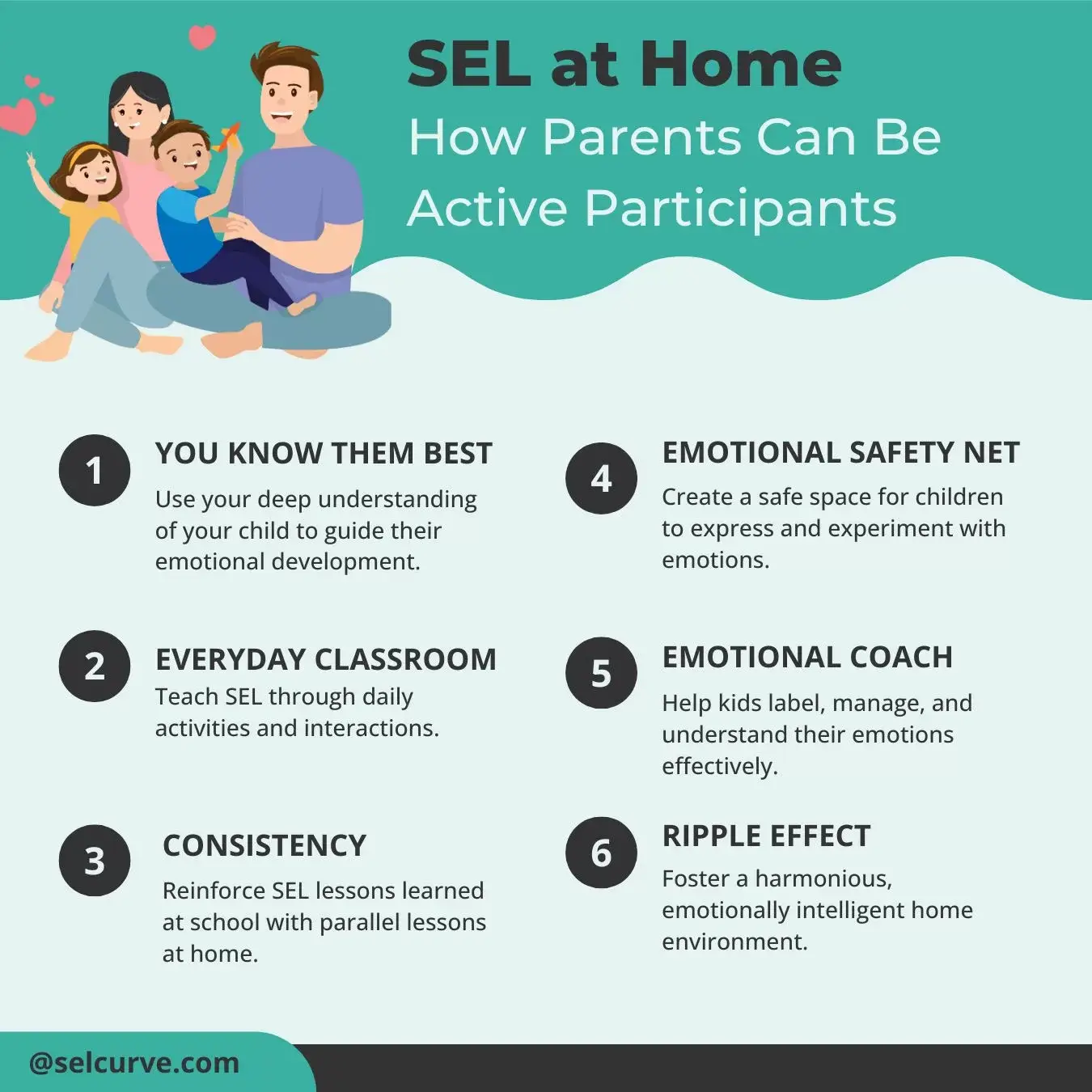
Let’s look at why parental involvement in this area is not just beneficial, it’s essential.
You Know Them Best 🌟
Parents, you’ve been there from the beginning, right? From the first cry to the first steps, and all the milestones in between. Who better to guide your child in their emotional development? You know your kids’ quirks, triggers, and comfort zones. This invaluable knowledge is a key ingredient in SEL.
So, parents, your unique understanding of your child is a powerful tool. Use it to actively participate in their SEL journey, shaping emotionally intelligent future adults.
The Everyday Classroom 🍽️🛌
Learning about emotions and social skills doesn’t just happen between the bells of the school day.
It’s in everyday moments—the sharing of toys with siblings, the polite request for dinner to be passed, or even in dealing with disappointment when a playdate gets canceled. These are your teachable moments.
Consistency is Key 🔑
Kids thrive on consistency. When they see the same messages being echoed both in school and at home, it strengthens their understanding and practice of SEL.
So when a teacher talks about empathy or conflict resolution in school, parents can back it up with parallel lessons at home.
Emotional Safety Net 🎯
Home is where kids can be their most authentic selves, warts and all.
By understanding SEL, parents can create an emotionally safe space for children to express themselves, experiment with social interactions, and even make mistakes to learn from.
Become an Emotional Coach 🗣️
Let’s be real, emotions can be confusing for adults, let alone kids!
Parents armed with knowledge of SEL can act as ’emotional coaches,’ helping kids label their emotions, manage them effectively, and make better social choices.
The Ripple Effect of Social Emotional Learning 💦
Ever notice how one family member’s mood can affect the whole household? By implementing SEL at home, parents can guide not just their children but also themselves toward a more harmonious, emotionally intelligent environment.
Practical Tip: Try a weekly “Family Feelings Roundtable” where everyone shares one emotion they felt strongly that week and discusses why. It’s a simple way to foster emotional awareness and empathy.
The beauty of SEL is that its benefits ripple out, creating a home environment where everyone—from kids to parents—learns, grows, and thrives emotionally.
So, dear parents, your involvement in your child’s social & emotional learning is a precious gift that keeps on giving. And don’t worry, you don’t have to be an expert! The beauty of SEL is that it’s a journey you take with your children, learning and growing together.
Next up, let’s dive into how embracing parenting as emotional coaching can work wonders. Stay tuned! 😊
Parenting with SEL 📣
So, we’ve already touched on the idea that parents can be ’emotional coaches,’ but what does that actually mean? How can you, as a parent, don the hat of an emotional coach for your child? 🎩💕
Embracing parenting as emotional coaching is like leveling up in a video game. You’re not just caring for your child’s basic needs. But you’re also deeply involved in navigating the complex terrain of emotions and social scenarios.
It’s like going from being a “caretaker” to being a “life coach” but with a strong emotional spin. And guess what? Understanding SEL is your cheat sheet!
Research indicates that children with emotionally supportive parents are better at emotional regulation and social interactions. So, dear parents, consider this your invitation to step into the transformative role of an emotional coach. Your guidance can make a world of difference in your child’s emotional and social development.
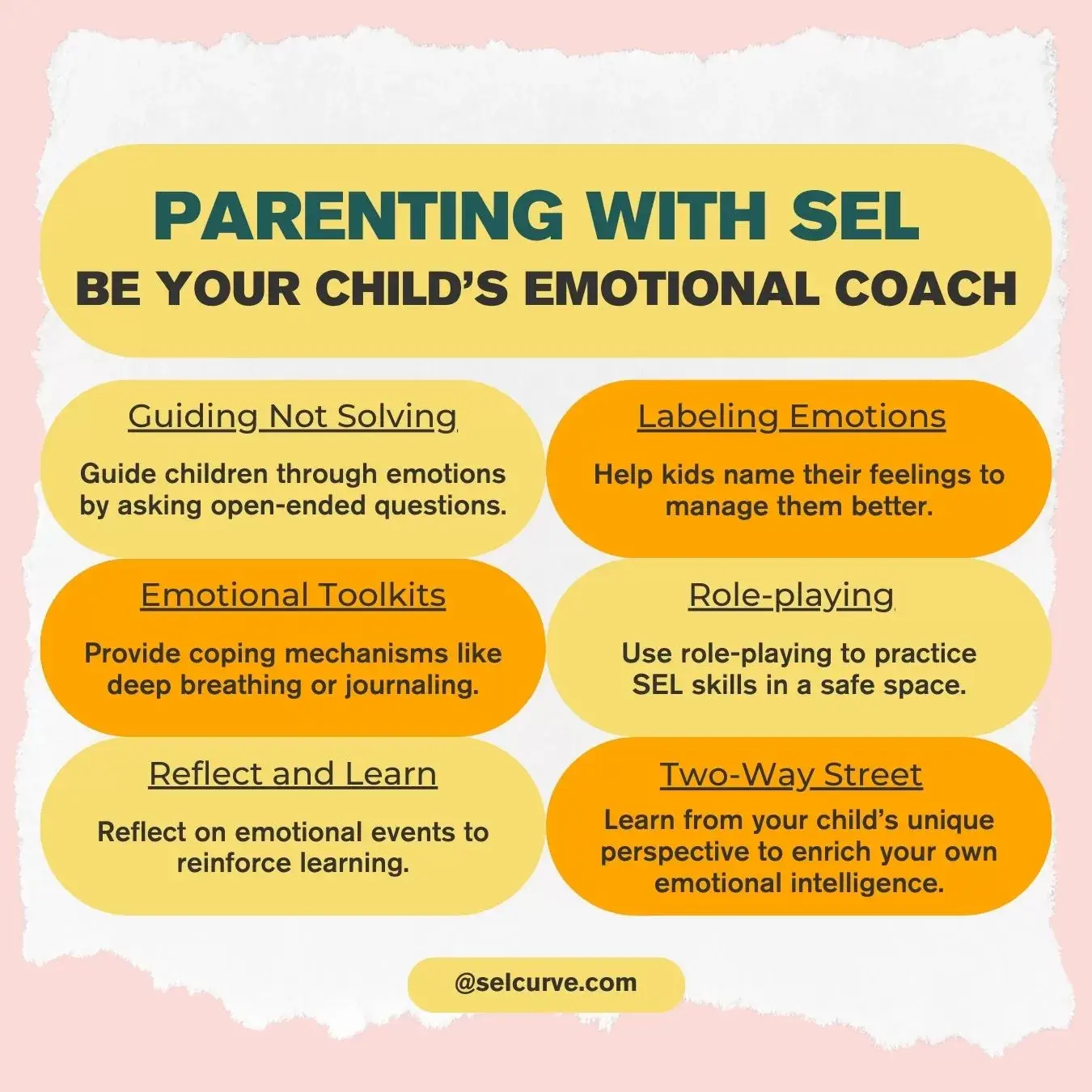
Guiding Not Solving 🗺️
As an emotional coach, your role isn’t to solve every emotional hiccup your child faces. Nope, it’s to guide them through it. Imagine your child comes home from school, upset because a friend didn’t want to play with them.
Instead of saying, “Don’t worry, you’ll make new friends,” you could ask, “How did that make you feel?” This opens the door to emotional exploration.
By guiding rather than solving, you empower your child to navigate their own emotional landscape. While building resilience and social skills along the way.
So next time your child faces an emotional challenge, try asking open-ended questions like, “What do you think you could do differently next time?”
Labeling Emotions 🏷️
Being able to name your feelings is the first step in managing them.
If your child says they felt sad when they were ignored, you can validate that emotion and then explore it. “It’s completely okay to feel sad in a situation like this. What could be a way to handle it next time?”
No, I’m not talking about actual toolboxes! An emotional toolkit is a mental stash of coping mechanisms.
For example, deep breathing for anger, or journaling for sadness. The more tools you give your children, the more equipped they’ll be to handle varied emotional situations.
Let’s Role-play! 🎭
Role-playing can be an effective way to practice SEL skills.
Maybe play out a scenario where your child has to share a toy or handle rejection. This gives them a safe space to experiment with different responses and behaviors.
Reflect and Learn 🤔💡
After an emotional event—whether it’s a meltdown or a display of great empathy—sit down and reflect on it with your child.
What went well? What could be done differently? This reflective process cements the SEL lessons learned and prepares your child for future scenarios.
It’s a Two-Way Street 🛣️
Remember, as much as you’re coaching your child, there’s a lot you can learn from them, too. Kids have a unique, unfiltered view of the world. And their honest reactions can often be insightful for adults as well.
Embracing the role of an emotional coach is not just a gift to your child; it’s also an opportunity for you to gain fresh perspectives and enrich your own emotional intelligence.
[wpdiscuz-feedback id=”44lvgxjlcw” question=”What do you think?” opened=”0″]Switching to the role of an emotional coach might feel daunting at first. But the great thing is, SEL is very forgiving. It acknowledges that we’re all humans who are continually learning. What’s important is the journey itself, and it’s a journey best taken together.[/wpdiscuz-feedback]
Up next, we’ll delve into how SEL can positively impact parent-child relationships. Keep reading! 😊
SEL for Parent-Child Bonds 🤝
Now, let’s jump right into how social emotional learning (SEL) can be the secret sauce that takes your parent-child relationship from good to amazing! 🌟
When it comes to parenting, we all wish there was a foolproof manual or guidebook. While that might be a wishful thought, SEL comes pretty close!
You know why? Because it’s all about understanding and managing emotions, not just for your child but also for you. And emotions, as we know, are the heart and soul of any relationship.
One parent, Sophia, shared how implementing SEL at home transformed her relationship with her 8-year-old son, Max. “We went from constant misunderstandings to meaningful conversations. It’s like we found a new language to express ourselves.”
So, dear parents, consider SEL your “secret sauce” for a more enriching and harmonious relationship with your children.
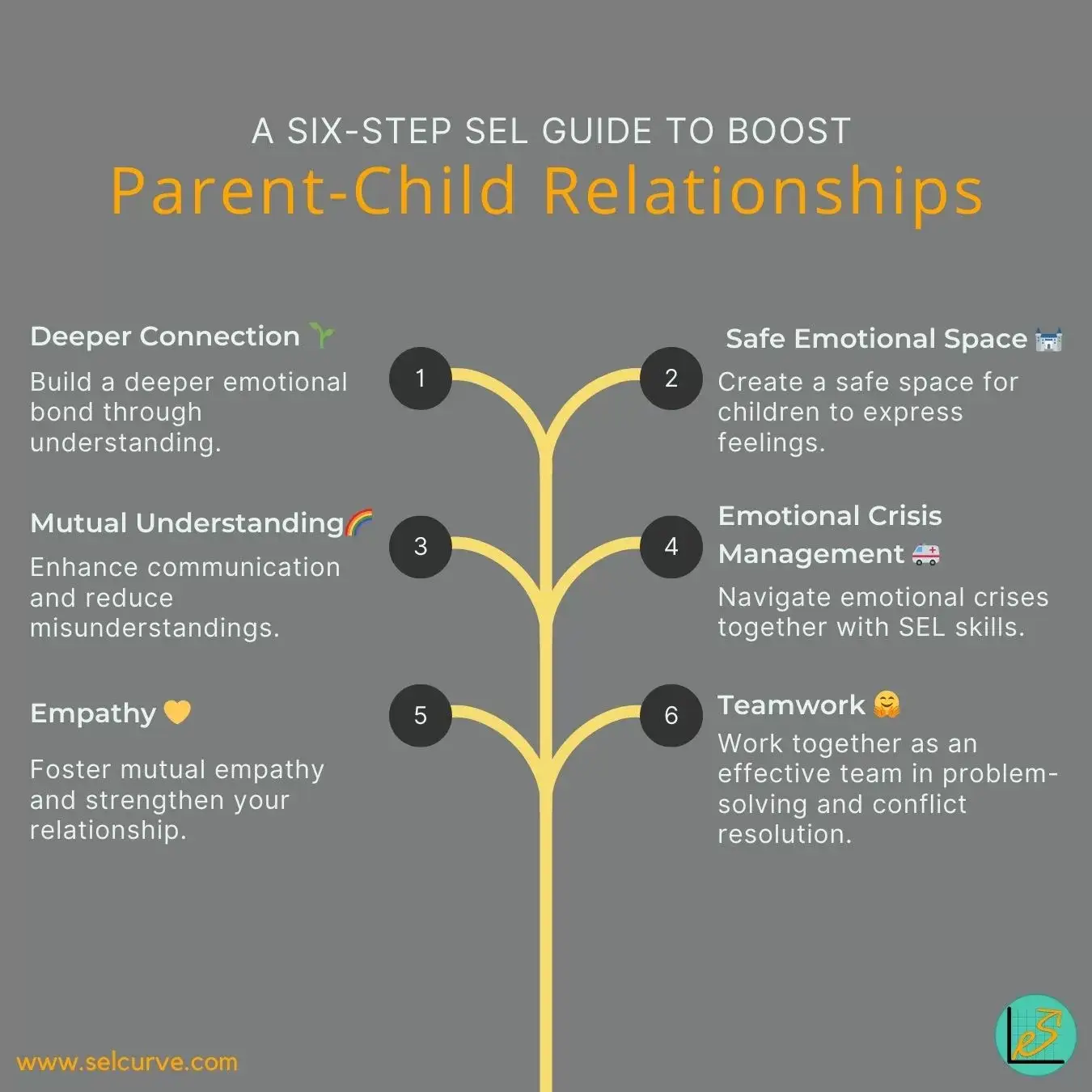
A Deeper Connection 🌱
First off, implementing SEL in your parenting strategy can lead to a deeper emotional connection with your child. When you understand what your child feels, it creates a sense of trust and openness.
It’s like being able to speak a secret language with your child that only the two of you understand. This deep emotional connection is not just comforting; it’s a cornerstone for a healthy, thriving parent-child relationship.
A Safe Emotional Space 🏰
Children often have feelings they don’t know how to express. Let’s face it, even us adults struggle with this!
When you practice SEL, you are effectively teaching your child that it’s okay to have feelings and share them openly. You become a safe space for your child to vent, explore, and understand their emotions.
The Joy of Mutual Understanding 🌈
Have you ever felt frustrated because you and your child were just not on the same page? SEL helps to eradicate these communication barriers.
By being more in tune with each other’s emotions, you’re less likely to have those “talking past each other” moments.
Emotional Crisis? No Problem! 🚑
Life isn’t all sunshine and rainbows. During emotional or stressful situations, a strong SEL foundation can be your anchor.
Whether it’s dealing with the loss of a pet, or anxieties about a new school, SEL equips you and your child with the emotional know-how to get through the storms together.
Empathy – The Golden Trait 💛
SEL teaches empathy, a cornerstone of any healthy relationship. When a child feels understood and listened to, they are more likely to reciprocate those feelings.
Imagine the warmth and closeness that develops when both parent and child are walking in each other’s emotional shoes.
Teamwork Makes the Dream Work 🤗
When both parent and child are fluent in the language of SEL, it’s like having an unstoppable tag team. From problem-solving to conflict resolution, the team dynamics are smoother because everyone understands the rules of emotional engagement.
Try setting aside a “Feelings Friday” where you and your child can share one thing that made you happy, sad, or frustrated during the week. It’s a simple yet effective way to practice emotional sharing and understanding.
By incorporating SEL into your family life, you’re not just enhancing your child’s emotional intelligence; you’re transforming the very fabric of your parent-child relationship into something deeply meaningful and resilient.
[wpdiscuz-feedback id=”44lvgxjlcw” question=”What do you think?” opened=”0″]Social emotional learning is more than just a parenting tool; it’s a relationship enhancer. By fostering better emotional understanding and communication, SEL can be the game-changer in your parent-child relationship. It’s like adding a dollop of whipped cream and a cherry on top of your already sweet relationship sundae![/wpdiscuz-feedback]
Coming up next, let’s look at why it’s so crucial for parents and teachers to be role models in the SEL journey. Stick around, it’s going to be eye-opening! 😊
Be Your Child’s SEL Hero 🦸♀️🦸♂️
We’ve been on quite a journey, haven’t we? Now let’s dive into the final, yet incredibly important part of our article: the role of parents and teachers as living, breathing role models for SEL. 🌟
Isn’t it fascinating how kids are like little sponges, soaking up everything around them? Whether it’s picking up a new skill or repeating a word they heard (sometimes the ones we wish they hadn’t!), children learn most effectively by observing.
That’s right! Little eyes are watching how you interact, manage stress, celebrate joy, and even how you handle anger.
According to a study by Yale University, children who are exposed to emotionally intelligent behavior in adults are more likely to develop these crucial skills themselves.
So, dear parents and teachers, you’re not just caregivers. You’re the ultimate SEL heroes shaping the future of emotional intelligence in our children.
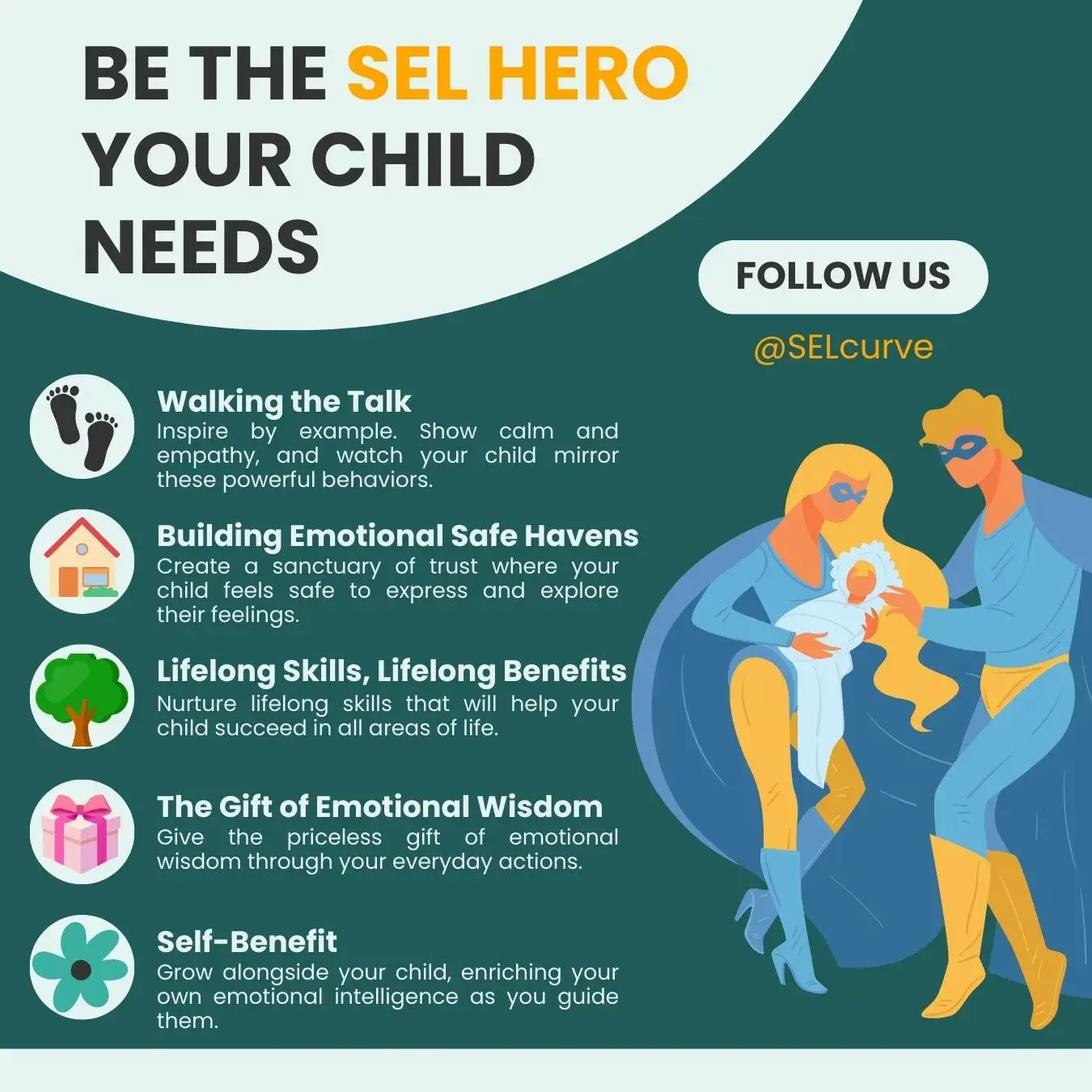
Walking the Talk 🚶♀️🚶♂️
Ever heard of the saying, “actions speak louder than words”? Well, when it comes to SEL, this couldn’t be truer.
Children often mirror the emotional behavior they see in adults. If they see you taking deep breaths when you’re stressed, they’re likely to do the same. If they watch their teacher handle a difficult situation with grace and empathy, that lesson is absorbed far more effectively than any textbook could teach.
The long-term advantage? Your actions today are the building blocks of your child’s emotional intelligence for a lifetime.
A simple tip: next time you feel stressed, verbalize your coping strategy. Say something like, “I’m feeling a bit overwhelmed, so I’m going to take a few deep breaths.”
Building Emotional Safe Havens 🏠
As parents and teachers, when we model good emotional behavior, we’re essentially building an emotional ‘safe haven’ for kids.
These safe havens are the environments where children feel secure to explore their feelings, ask questions, make mistakes, and learn—all because they’ve seen us navigate our emotional worlds successfully.
These environments significantly encourage children to explore their feelings and learn. Consider the approach of Mrs. Reese, a teacher who initiates each class session with a “feelings check-in.” Her students feel comfortable sharing their emotions, knowing they’re in a safe space.
Lifelong Skills, Lifelong Benefits 🌳
Remember, the SEL competencies you’re modeling are not just short-term life hacks; they are lifelong skills.
When you model strong interpersonal relationships and effective emotional communication, you offer a valuable blueprint. This guide will assist them in forming successful relationships in various aspects of life—whether it’s friendships, work interactions, or romantic connections. 🌟
So, let’s commit to making Social Emotional Learning a lifelong gift we give to our children.
The Gift of Emotional Wisdom 🎁
Teaching by example offers an invaluable gift—the gift of emotional wisdom.
Being emotionally savvy won’t just serve children well in their personal lives; it’s also an asset that will make them stand out in their future professional lives.
Employers are increasingly recognizing the value of emotional intelligence. And it all starts with what kids learn from their role models—you!
Let’s Not Forget Self-Benefit! 🌺
Modeling good SEL practices isn’t just beneficial for the kids; it’s good for you too! Practicing SEL enriches your own emotional intelligence, making you a better parent, teacher, and overall human being.
The act of being a good role model often means you’re also continually reflecting on and improving your own emotional skills. It’s like a circle of emotional well-being where everybody wins!
A quick tip: take a moment at the end of each day to reflect on one emotional skill you practiced well. And one you’d like to improve on.
There you have it, the grand finale! Being a role model in social emotional learning is not just a duty but a golden opportunity to imprint life-enhancing skills on young minds. So go on, be the SEL superhero your child deserves, because you’ve got the cape—they’re just waiting for you to fly!
Stick around as we end our journey through this fascinating world of SEL, offering you insights, tips, and a whole lot of heart! 💖
Conclusion: SEL for a Better Future 🌈
Wow, what a journey we’ve been on together! From understanding what social emotional learning (SEL) is to exploring its profound impact on our kids and ourselves, we’ve navigated some essential landscapes, haven’t we?
Here at SEL Curve, our mission is to empower each of you—our invaluable parents and dedicated teachers—to be the architects of future. A future where emotional intelligence and social skills are celebrated just as much as academic achievements.
To our cherished SEL Curve community, we invite you to be active participants in this collective journey toward emotional well-being. Your involvement is the heartbeat of our mission.
Consider the story of Emily, a proactive parent in our SEL Curve community. She told us how embracing Social Emotional Learning at home revolutionized her bond with her son. “Before SEL, we were like two ships passing in the night. Now, we’re more like a team, navigating life’s challenges together,” Emily shared. 🏡
You’ve Got This! 💪
Know that you are already doing an incredible job. Even by being here, reading this, you’re taking steps to invest in the emotional well-being of the children in your life. And that’s something worth celebrating!
Each small effort you make has a ripple effect that transcends classrooms and households, affecting communities and society at large.
A Journey of Shared Wisdom 📚
We understand that the road to fostering emotional well-being isn’t always straightforward. That’s why we’re committed to walking beside you every step of the way.
With our evidence-based resources, stories that touch the heart, and strategies that really work, we’re more than just a platform; we’re a community.
Always Here to Support You 🤗
You’re not alone. At SEL Curve, you’ll always find a haven of information, guidance, and inspiration.
Together, we’ll tackle challenges, celebrate milestones, and continuously seek innovative ways to enhance the emotional lives of our children.
Let’s Keep the Conversation Going! 🗨️
[wpdiscuz-feedback id=”44lvgxjlcw” question=”Please reach out to us” opened=”0″]Whether it’s a question you have, a story you want to share, or even a hurdle you’re struggling to overcome, we’re always here to listen and lend a helping hand. Reach out to us; your experience adds to the collective wisdom of our vibrant community.[/wpdiscuz-feedback]
So let’s roll up our sleeves and dive in, because the beautiful thing about learning is that it never stops—and the most beautiful part about emotional learning is that it has the power to make all of us better humans, from the inside out.
With all the love and encouragement in the world, let’s embrace the journey ahead. We can’t wait to see where this path of emotional empowerment takes each and every one of us. Here’s to a future full of emotionally intelligent, socially skilled, and above all, happy children!
Feel the love, be the change, and stay ahead of the curve with SEL Curve. 💖
Until next time, take care and keep shining! ✨

